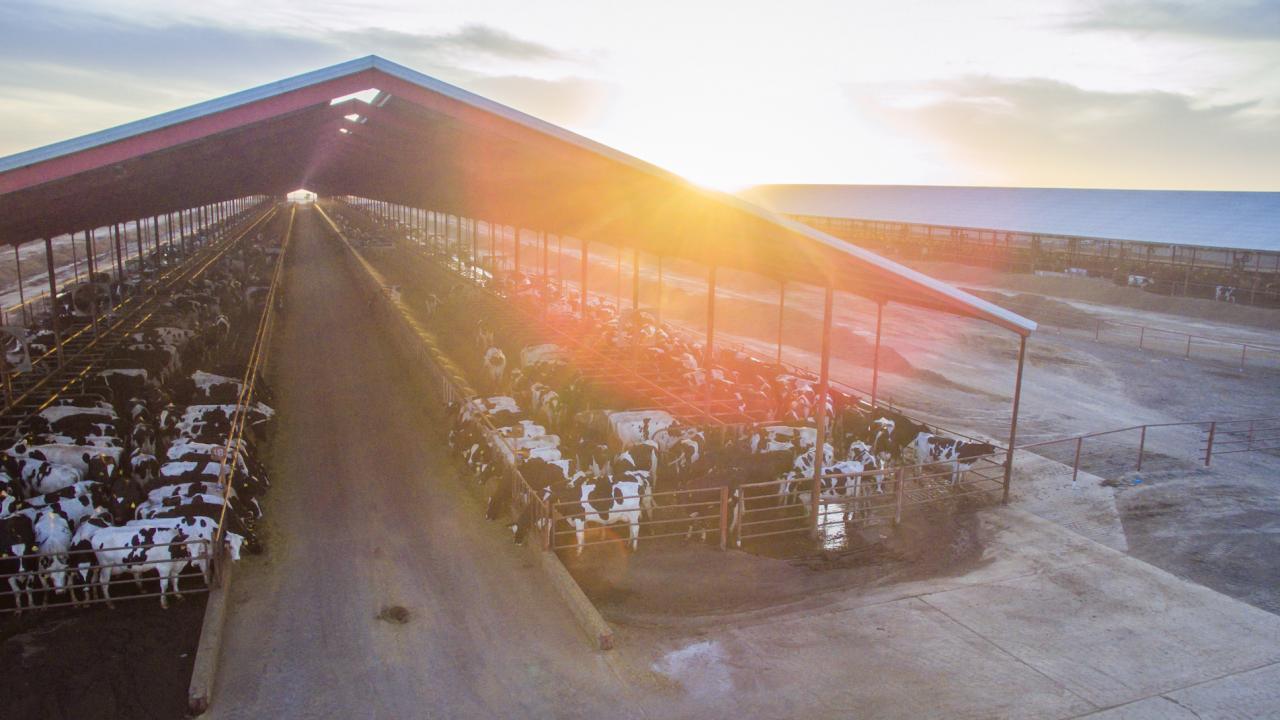
Too Much, Too Little, Just Right — Nitrogen Management on Dairy Farms
Many conversations around animal agriculture and the environment focus on the relationship between carbon and cows. However, nitrogen, which is present on farms from the livestock feed to soil to dairy excrement, is of equal concern. Dairy farmers’ management of nitrogen quantity and quality can have major economic, environmental, and human health implications.
The Nitrogen Cycle
Nitrogen is a key component of protein, which makes up animal muscles, plants, and milk. The nitrogen cycle begins on farms in the form of feed that dairy cattle eat. The feed includes forages (e.g., alfalfa hay) and various byproducts such as soybean meal and distillers grains. Protein is an essential part of the diet and cows need it to consume it to maximize health and milk production. Just like in humans, not all the protein cows eat is used by the animal for making muscle tissue or milk. Therefore, the unused portion leaves the body in urine and feces. This dairy excrement is then collected on farms to fertilize crops and to ensure high-yielding harvests. Once applied to farm fields, nitrogen can go many routes including the atmosphere, be lost to water bodies, or utilized by plants to grow. Those same crops are then fed back to cows and the nitrogen cycle begins again. Problems can arise when there is too much or not enough nitrogen in one part of the cycle at any given time. Thus, dairy farmers make it a priority to manage the right amount of nutrients for the health of their farms and their community.
Why nitrogen must be managed
Dairy excrement is made up of two components, feces and urine. When kept separate, they don’t cause much trouble, but this isn’t practical on a conventional dairy farm where cows choose when and where they excrete. When they are combined to form manure, the nitrogen in the urine reacts with enzymes and microorganisms in the feces that cause it to break down and form ammonia molecules (NH3). These molecules contribute to the certain aroma that you may have encountered when you drive past a livestock operation. These ammonia molecules are a building block in forming fine particulate matter (PM). This material is incredibly small at only 1/10 the width of a single human hair. Too much PM in the air leads to poor air quality and it can also negatively impact human health and lead to coughing, aggravated asthma, and decreased lung function.To minimize the buildup of ammonia production in the places where cows eat and sleep, flush systems (Figure 1) are used to remove excrement from the cows’ living area. Think of the flush system as a toilet that’s using water to flush the urine and feces from the alleyway into a drain. These flush systems operate anywhere from 3-6 times a day depending on farm management practices.
All dairy excrement is then collected and goes to a manure storage system. These holding systems vary by farm, but one of the most common is a lagoon storage system (Figure 2). Lagoons are wide open-air pits in the ground where thousands of gallons of wastewater are held before being used to irrigate and fertilize crops. The lagoon wastewater can also be reused again through the flush system to remove manure from the housing areas. It is imperative to properly manage and contain this source of wastewater as any wastewater leaking could potentially contaminate soil and water sources. Thus, dairy farmers are working closely with crop and environmental consultants to prevent the negative environmental impacts of wastewater leakage and ensure this fertilizer can be properly utilized for crops.
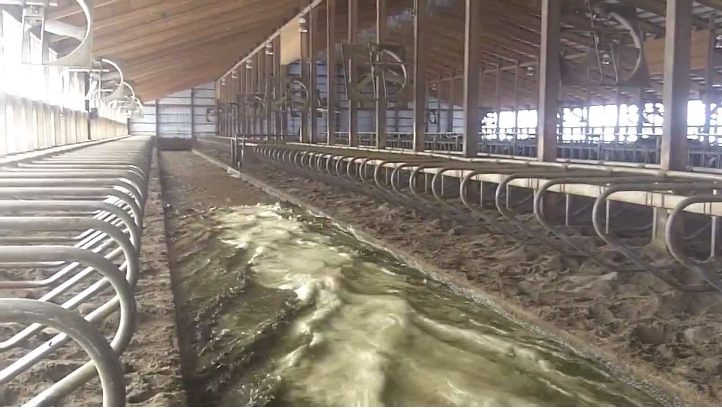
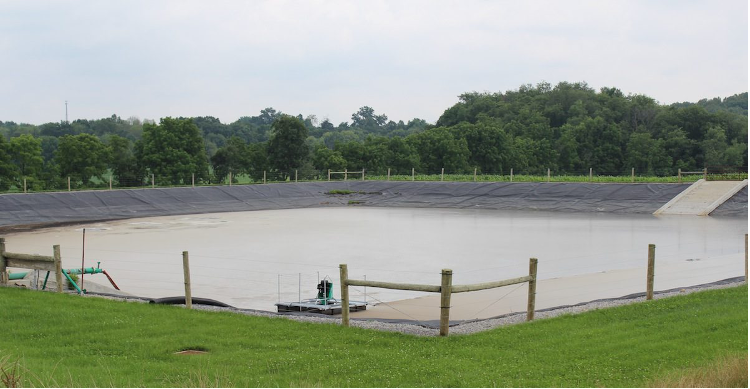
Along with managing the nitrogen from being lost to the soil, dairies must also look to manage nitrogen losses to the air. When dairy excrement is held in the storage system, it undergoes degradation and combines with oxygen to form nitrous oxide (N2O) gas. These molecules are also known as laughing gas, but there’s nothing funny about them. They are a greenhouse gas with a warming effect 265 times greater than carbon dioxide over a 100-year timespan. For every one molecule of nitrous oxide in the atmosphere, it has the same warming effect as 265 carbon dioxide molecules. While this is one of the most potent greenhouse gasses, the quantity produced on farms is much smaller compared to methane (CH4) and carbon dioxide (CO2), the other two main greenhouse gasses of dairy production.
Growing plants for cattle feed requires fertilizer, which is applied near the beginning of the growing season, when they need the nitrogen the most. Fertilizers come either from synthetic fertilizer blends or natural manure sources. With an immediate source of nitrogen available in their lagoon storage systems, dairy farmers work with their nutrient management planners to determine how often and at what rate to fertilize the fields. It is common for dairy farmers to apply fertilizer at agronomic rates, which is at the rate of the exact amount of nutrients that a certain crop requires to grow. If a farm were planning to grow corn to make into tasty corn silage feed, it would first determine how much nitrogen is in one gallon of lagoon water. This would be followed up with an assessment of a soil test to determine nitrogen concentrations already in the ground. Based on research that has determined how much nitrogen is required to grow corn, farmers can evaluate how much nitrogen is in the soil and the additional amount they need to apply. The concentration of lagoon water nitrogen will determine how many gallons farmers will apply to each acre of cropland. By using agronomic rates to measure fertilizer application, it ensures farms are using the just right amount of nutrients. Over-application could lead to surface and ground water contamination and potential formation of nitrous oxide. Whereas not enough nitrogen could hamper crop yields and as a result, the amount of feed harvested for cows. Once this feed is harvested each year, it’s fed to cows as part of their balanced nutrition and the nitrogen cycle continues.
Improving Nitrogen Utilization on Farms
Dairy farmers are doing the important work to ensure that nitrogen is properly managed on farms. However, new technologies have emerged that allow farmers to precisely manage nitrogen utilization. Dairy farmers can minimize losses throughout the nitrogen cycle and reduce the amount of nitrogen they need to buy.
The first way to improve nitrogen use on dairy farms is by feeding an appropriate amount of protein to cows. Cows have a certain requirement for amino acids, which are the building blocks of proteins. Half of all amino acids are essential, which means they must be consumed every day to optimize health and production. However, some of these amino acids are needed in greater quantity compared to others (Table 1). One way this optimal supply could be achieved is overfeeding protein to have insurance against underfeeding essential but limited amino acids that are responsible for achieving health and milk production. However, when cows are fed excess protein, just like with humans, they excrete the extra nitrogen in their urine and feces. Although the farmer now has more nitrogen in the manure, it also hurts their profitability as they’re paying for feed the animals cannot use. On the other hand, by working in line with their nutritionist, dairy farmers can feed a lower total protein and supplement with specific essential amino acids added that are the most important for achieving optimal health and milk production. This practice is known as amino acid balancing and is most commonly observed when feeding the supplemental essential amino acids of lysine or methionine. This balanced feeding strategy ensures cows will have the exact amount of amino acids they need for health and milk production, while minimizing the amount of nitrogen that becomes wasted and negatively impacting the environment.
|
Amino Acid |
Quantity (g/day) |
Percent of Total EAA |
|
Arginine (Arg) |
155 |
10% |
|
Histidine (His) |
69 |
5% |
|
Isoleucine (Ile) |
164 |
11% |
|
Leucine (Leu) |
260 |
17% |
|
Lysine (Lys) |
230 |
15% |
|
Methionine (Met) |
87 |
6% |
|
Phenylalanine (Phe) |
163 |
11% |
|
Threonine (Thr) |
163 |
11% |
|
Tryptophan (Trp) |
45 |
3% |
|
Valine (Val) |
189 |
12% |
Table 1: The amount of each essential amino acid (EAA) dairy cows must consume in their feed every day assuming a 1500-pound cow producing 80 pounds of milk per day. Note: The greater the quantity of an amino acid required for a cow does not indicate its importance over another amino acid (Table adapted from Van Amburgh et al, 2015)
Precision agriculture is a practice that can be used to accurately utilize nitrogen from the animal to crops. This practice focuses on fertilizing different sections of a field based on exactly the amount of nutrients they need. Crop fields are extremely diverse in their soil types and nutrient concentrations, and there can be huge variations in yields. Dairy farmers have been able to implement technologies and sensors that can vary the number of nutrients applied to each section depending on nitrogen needs. Providing the appropriate amount of nutrients for each section will achieve greater yields than if fertilizer was uniformly applied.
The historical approach to apply fertilizer was to broadcast it to only the top of the soil. This is certainly the easiest method to apply manure or chemical fertilizer; however, nutrients present on the soil surface are more easily lost to the environment and diverted from their real target – the plant roots. Surface application of fertilizer can also lead to emissions of nitrous oxide from fields. Furthermore, if it were to rain, then the nutrients could be washed off the soil into surface- or ground water bodies. When present in water, the nitrogen can form nitrate (NO3-) or nitrite (NO2-) compounds, which have negative human health consequences when consumed in drinking water. Newer technologies allow farmers to directly inject fertilizer into the soil (Figure 3). This increases the amount of nutrients that stay close to the plants’ roots when they need them. By using these technologies and working with nutrient management planners, a greater percentage of the nutrients applied can stay on the farm, which further reduces the environmental impact of production.
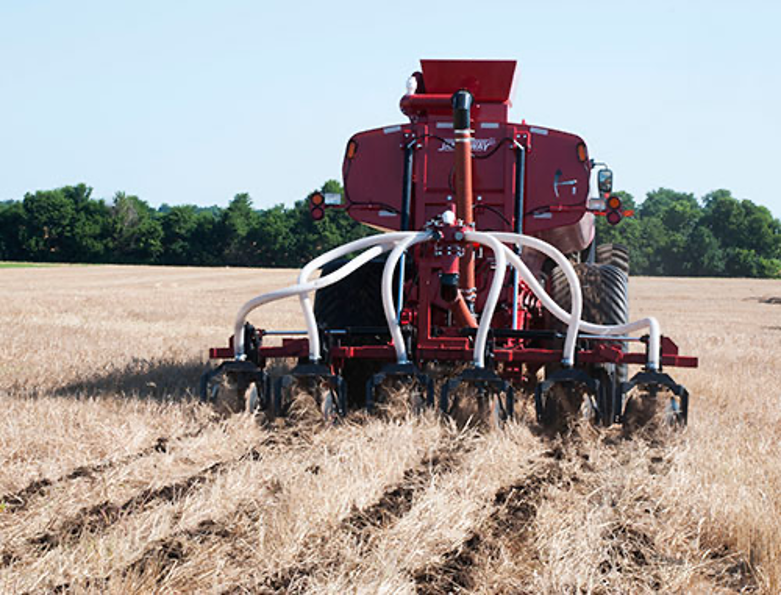
Many dairy farms in California are implementing anaerobic digester systems, which can reduce greenhouse gas emissions and provide a renewable energy source via the production of electricity or natural gas (Figure 4). After digesters have harnessed the energy from manure, the remaining product is known as digestate or effluent and it contains high nitrogen concentrations. Digestate has traditionally been utilized as a source of fertilizer. However, compared to wastewater nitrogen, most nitrogen effluent is present in the inorganic form of ammonium (NH4+). This form of nitrogen can be utilized by plants, but it is also more likely to rapidly form the other nitrogen species of nitrate, nitrite, or nitrous oxide, which all carry their own negative environmental outcomes. Therefore, if digestate is to be utilized as a source of fertilizer on farms, it should be applied with the precision strategies mentioned earlier to ensure that the nitrogen stays at the plant roots and to prevent its lost to the environment.
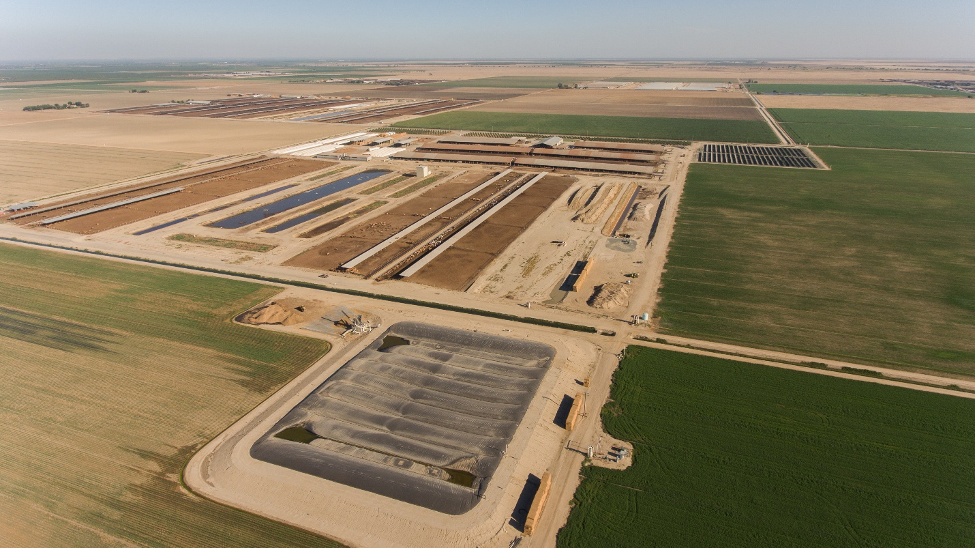
Dairy digestate management has recently been advanced into a priority research area with solutions looking to make digestate nitrogen more available to crops or to reduce total nitrogen density. These strategies include struvite precipitation, ammonia stripping, and vermifiltration. Here we’ll focus on the last one, which incorporates organic matter such as shavings or sawdust to help filter out this concentrated nitrogen. This filtration system can remove up to 90% of nitrogen and other nutrients such as phosphorus from the effluent. The product of vermifiltration is rich compostable material that can then be applied to fields in much greater quantity than if effluent was applied alone. Not to mention, with the removal of nitrogen species, there is also a reduction in the formation of nitrous oxide molecules. Additional opportunities in effluent management have looked at using certain additives or microbials that can be added to reduce the production of various gasses. Research continues to identify solutions with major climate and human health implications as dairy digesters increase in their popularity and density across the dairy farm landscape to help the industry meet their climate and economic sustainability goals.
Ensuring Nitrogen Management
By managing nutrient use, dairy farms are uniquely poised to improve human and planet health. Farms are implementing multiple practices to keep nitrogen circulating in a close looped system. From cattle manure to nourishing growing crops, which are then fed back to the animal, this cycle continues 24/7 365 days a year. Maintaining this cycle reduces the amount of fertilizers that farms need to purchase and can improve profit and environmental outcomes. By ensuring this on-farm circularity, farmers maximize efficiency, reduce pollution, and continue to be strong environmental stewards.
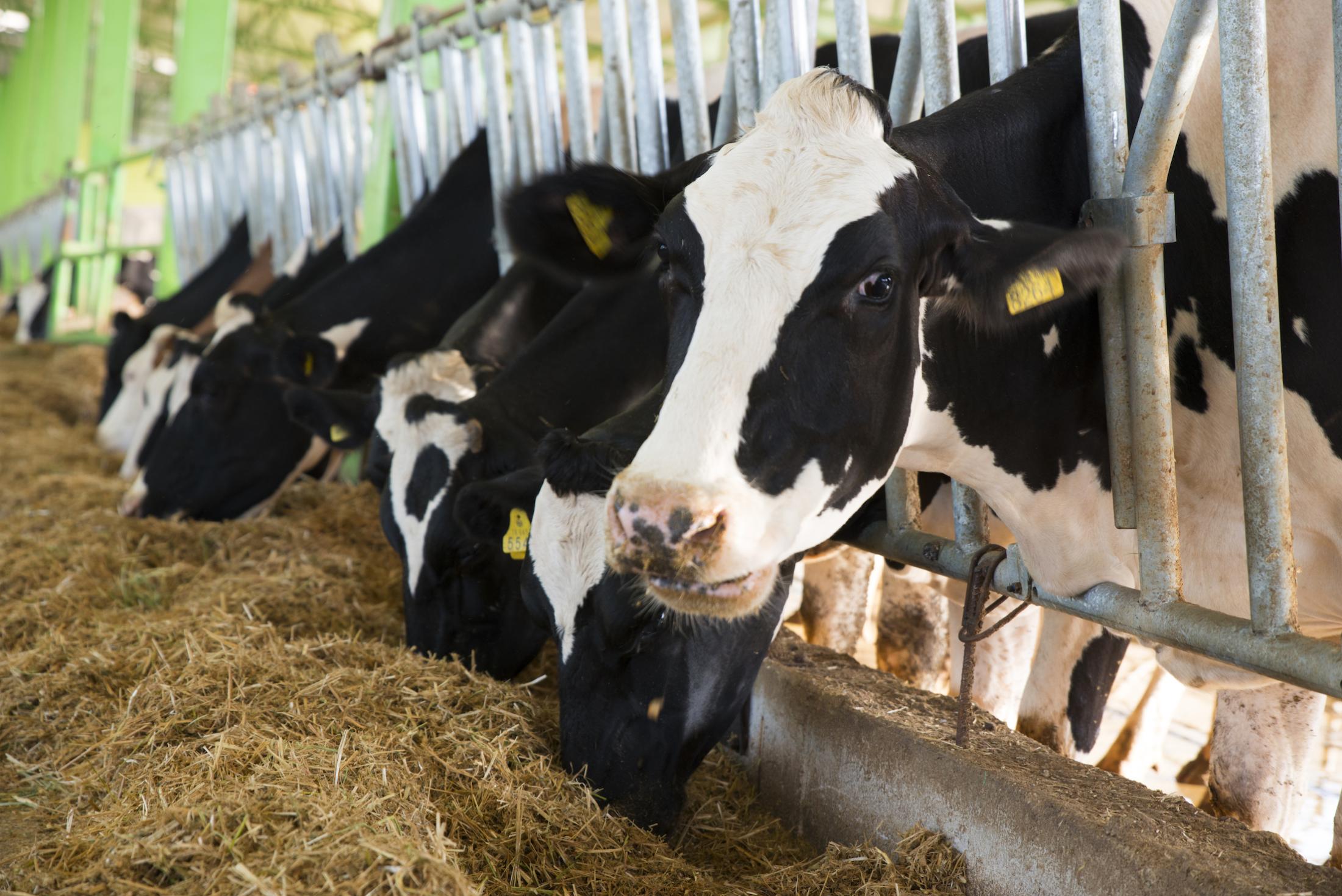
How dairy milk has improved its environmental and climate impacts
Mitloehner lab Ph.D. student Conor McCabe, M.S. explains that with innovation and technology like improved breeding genetics, nutrition research, and better veterinary care a glass of milk today has a much lower environmental footprint than even a few decades ago.
